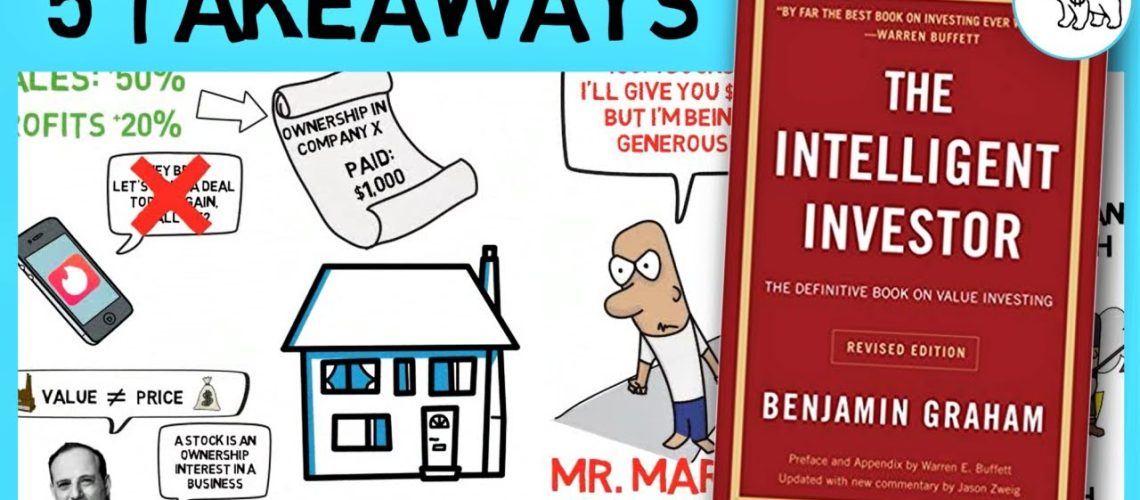This video presents the 5 greatest takeaways from Benjamin Graham’s classic, The Intelligent Investor. This is value investing at its greatest.
Video by the Swedish Investor
Key Takeaways
Instead what’s needed is a sound intellectual framework for making decisions, combined with an ability to keep emotions from ruining it.
In “The Intelligent Investor”, Benjamin Graham presents such a framework together with logic that will help to keep your emotions under control.
Among these, the brightest shining star is Warren Buffett, who, at the time of this video making, is the third wealthiest man in the world. Warren Buffett refers to this book as “by far, the best book on investing ever written”.
Here are the greatest takeaways from the book.
1. Meet Mr. Market
Furthermore, he offers to buy your share or sell you an additional one on that basis.
History has shown that Mr. Market’s opinion about how much your part of the business is worth, can be pure gibberish.
But for the investor who can keep his head cool, Mr. Market presents a great possibility of making money, for he doesn’t force you to strike a deal with him, he merely presents you with an opportunity of doing so!
We must consider that, at the time when Graham wrote this book, people were far less bombarded with news, forecasts, stock quotes, and so on than we are today.
Back in the 1970s, Mr. Market arrived maybe once a day, together with the morning newspaper. Today, he wants to do business with us every time we open our phone. Which, if you’re anything like me, is more than 100 times every day.
Just because Mr. Market visits you more often, it doesn’t mean that you must trade with him any more frequently than people had to in the 1970s. If he doesn’t present you with an offer that meets your standards, ignore him, and move on with your day!
2. How to Invest As A Defensive Investor
There are two types of investors according to Graham – the defensive (or passive) one and the enterprising (or active one).
Most people are better suited for the defensive strategy, as the time they are willing to dedicate to investing is limited.
The defensive investor should create a portfolio with a mixture of bonds and stocks, say 50% stocks and 50% bonds. Note that how much you should devote to each asset category depends on your life situation and the current difference in the average yield of stocks versus bonds.
Invest a fixed amount of capital at regular intervals. For instance, straight after you get your salary. This is called dollar-cost averaging, and will allow for a fair average price of stocks and bonds. Most of all, it will assure that you don’t concentrate your buying at the wrong time.
For the stock component of the portfolio, the defensive investor should aim for the following 8:
1: Diversification in the companies he invests in. 10 to 30 companies should be adequate. Also, make sure that you are not overexposed to a single industry.
If you are satisfied with an average reward through your investing, you only need these two first takeaways.
3. How to Invest As An Enterprising Investor
If you, on the other hand, can find a company which is valued lower than its net working capital, you essentially pay nothing for all the fixed assets, such as buildings, machinery goodwill, etc.
Note that there is no constraint at all regarding company size. Also, some diversification should be applied, but the number of companies held isn’t carved in stone for the active investor.
4. Insist On A Margin of Safety
There’s one risk that no careful consideration can truly eliminate: the risk of being wrong. You can, however, minimize this risk.
To do this, you must insist that every investment you make has a “margin of safety”.
There’s a huge discrepancy here! Amazon is expected to grow at 74% per year according to its stock price, while Apple is expected to grow at a mere 5.8%. Do you think that this is reasonable?
5. Risk and Reward Are Not Always Correlated
According to academic theory, the rate of return which an investor can expect must be proportional to the degree of risk that he’s willing to accept.
Story:
“I thought so” he replies …”What about $100,000 for taking two shots?”
In the first offer, you were to receive $10,000 at a 16.7% risk of blowing your brains out. In the second offer, the reward is $100,000 because the risk of putting a hole through your head has increased to 33.3%.
Quick Recap
Firstly the market tends to be over-optimistic and too pessimistic from time to time. Don’t let this influence what you think the true value of your assets are.
Instead, see it as a business opportunity, where you get to deal with a person who has no idea of what he’s doing!
Secondly, the defensive investor should go for a diversified portfolio of stocks and bonds, where the stock category consists of primarily low-priced issues.
Thirdly, the enterprising investor should also aim for stocks that show lower price tendencies. If he can find a company that is trading below its net working capital, he might have found his El Dorado.
The fourth takeaway is that the intelligent investor should insist on a margin of safety when acquiring an asset.
Takeaway number 5 is that risk and reward aren’t necessarily correlated.
What do you think of Graham’s advice? Are they still as applicable today, as they were back in the 1970s?

